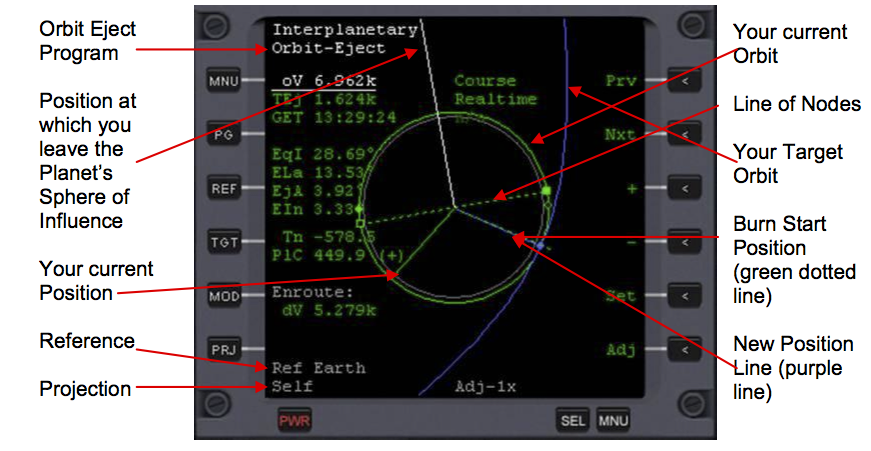Difference between revisions of "IMFD Orbit Eject"
(Original from IMFD Full Manual 2009) |
(Added categories.) |
||
| (One intermediate revision by the same user not shown) | |||
| Line 72: | Line 72: | ||
|style="text-align:right" width="33%" |[[IMFD_Base_Approach|IMFD Base Approach Program]] | |style="text-align:right" width="33%" |[[IMFD_Base_Approach|IMFD Base Approach Program]] | ||
|} | |} | ||
| + | |||
| + | [[Category: Articles|IMFD Manual 13]] | ||
| + | [[Category: Tutorials|IMFD Manual 13]] | ||
| + | [[Category: IMFD Manual|IMFD Manual 13]] | ||
Latest revision as of 11:49, 14 October 2022
| IMFD Surface Launch Program | IMFD Manual Contents | IMFD Base Approach Program |
IMFD Orbit Eject Program[edit]
Orbit eject is probably the easiest program to use. It is used for escaping from the current planet you are orbiting—a necessity required when traveling between planets or moons. However, it is not required when traveling from the Earth to the Moon because you never leave the influence of the Earth. So, in order to use this program, you must leave the source planet‘s SOI. In the program, there are five items those can be modified. (oV) is the outward delta velocity, that‘s the velocity added to a velocity of the planet. (TEj) is the time to the ejection. The ―Burn mode‖ item is used to select the burn mode, which can be off-axis or realtime.
The Green dashed line is the position for the burn recommended by the flight computer. Time to Burn (TtB) will tell how long it takes to reach this position. This is the position at which Autoburn will begin the burn.
Burn Mode
There are also two different burn modes available—Realtime and Off-Axis. Realtime mode is a good one for escaping from the low gravity bodies. This mode uses a burn vector to eject the ship towards a correct heading. However, this mode is slightly more inefficient in long burns, but works perfectly. The Off-Axis mode is created for long burns and it uses a Pro-grade burn. So, use a PG autopilot or the autoburn feature to complete the burn. If you use the prograde autopilot, turn on Burn Vector View and make sure that the cross stays centered. It may deviate, at which point you should turn off the prograde autopilot and rotate the ship manually to center the cross. Off-Axis mode is not available if (EIn) is greater than 1.0 degrees. Nor it is available during the liftoff. In a highly elliptical orbit the integration of the exact burn position may take a few seconds. The position is integrated with high accuracy and you should end up exactly in a correct heading after the burn. Do NOT switch between realtime and off-axis during the burn.
Orbit Eject Display Screen
Note that the button layout is the same as the Course Program with one exception—there is no source or center button on the second page (accessed by hitting PG). Once the burn starts the green line (current position) disappears and the purple line (New Position Line) becomes your new current position line.
Text Items:
oV—Outward Velocity
The outward velocity that you inputted or that another program sent the Orbit Eject Program. To get another program to send data to the Orbit Eject Program please see the Data Source item below.
TEj—Time to Ejection
Time in seconds until the burn must start.
GET—GET of Ejection Burn
The GET at which the burn must start.
Data Source—Data Source
This is where the Orbit Eject Program gets its data. Options are Lower Orbit, Higher Orbit, Course, BaseApproach, and Slingshot. Higher Orbit and Lower Orbit require a manual input of oV, while the other three get that number from their respective programs. You must use shared mode if you want to use data from another MFD.
Burn Mode—Burn Mode
Burn Mode being used. Options are Realtime and Off-Axis.
EqI—Equatorial Inclination
Current inclination with respect to the equator.
EjA—Ejection Angle
Ejection Angle for Transfer Orbit.
EIn—Ejection Inclination
Current Ejection Inclination.
Tn—Time to Node
Time to the next node. If negative, then it is time since the last node.
PlC—Plane Change Velocity
Amount of dV required for the Plane Change burn.
dV—Delta Velocity
Delta Velocity required to match your current orbit with the target orbit.
| IMFD Surface Launch Program | IMFD Manual Contents | IMFD Base Approach Program |
